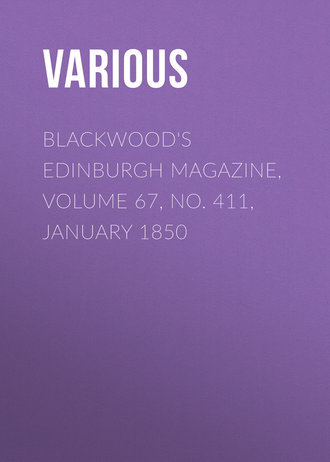 полная версия
полная версияBlackwood's Edinburgh Magazine, Volume 67, No. 411, January 1850
This fort, or castle, was probably the same that was, a few years afterwards, taken by the stratagem of the patriotic yeoman, Binnock, in concealing some of his followers in a waggon of hay; and who was rewarded by King Robert with an estate, which his posterity long afterwards enjoyed.
13
Dalmeny Church is unquestionably of very great antiquity. From the style of its architecture, which a most competent authority, Mr Billings, ("Baronial and Ecclesiastical Antiquities," vol. i.) has pronounced to be of the purest Norman, it is referred, at least, to the tenth or eleventh centuries. There is extant a charter of Waldeve, Earl of Dunbar, from 1166 to 1182, witnessed by the parson of Dumanie.
14
On these banks a castle was afterwards erected by the Earls of Wintoun, the picturesque ruins of which are yet a prominent object, by the edge of the Edinburgh and Glasgow Railway, to the west of Kirkliston. Queen Mary is said to have slept there, on her flight from Lochleven to Hamilton, 2d May 1568.
15
The name has for centuries been vulgarised into Craigmillar. Adam de Cardonnel, in his "Picturesque Antiquities," adheres to the spelling in the text; although it is generally now admitted that the appellation is Gaelic —Craig-moil-ard, or the high bare rock running out into a plain. The original structure is of unknown antiquity.
16
Woolmet, or Wymet, and Inneresc, were granted by charter of David the First to the Abbey of Dunfermline; the latter in confirmation of a previous grant by Malcolm Canmore and Queen Margaret, ("Registrum de Dunfermlyn," Imp. Edin. 1842, p. 5, 6.) A small mausoleum of the Wauchope family now occupies the site of the chapel of Wymet; and the venerable pile of St Michael the Archangel, at Inneresc, was ruthlessly demolished in 1804. The house in which the great Randolph died, which was about half a mile distant, was also hewn down, about ten years afterwards, to make way for a shabby masonic lodge.
17
The family of Cospatrick, a powerful Northumbrian nobleman, took refuge in Scotland after the death of Harold at Hastings, and in 1072 had extensive lands in the Merse and Lothian gifted them by Malcolm Canmore. They continued to be one of the most opulent and powerful houses in the east of Scotland for a considerable period, as evidenced by their donations, noted in the chartularies of Coldingham, Newbottle, Dryburgh, Kelso, Melrose, and Soltra. Founded on a steep rugged rock, within sea-mark, and communicating with the land through a covered passage, the castle of Dunbar might well, before the invention of gunpowder, have been deemed impregnable. It was often the theatre of warlike contention, and two great battles were fought in its immediate neighbourhood, – the first in 1296, when Earl Warenne defeated the army of Scotland sent for its relief; and the second in 1650, when Leslie was overthrown by Cromwell. It was often besieged, and as often bravely defended; but perhaps never so brilliantly as by Black Agnes against the Earl of Salisbury in 1337.
18
This venerable memorial, which gives the name of "Queen's Cross" to the neighbouring locality in Northamptonshire, is a beautiful specimen of architecture, although much defaced by time, and the efforts of renovators.
The "trellised" vest, mentioned in stanza XXIV., was a species of armour, so called by contemporary Norman writers; and consisted of a cloth coat, reaching only to the haunches. This was intersected by broad straps of leather, so laid on as to cross each other, and leave small intervening squares of cloth, in the middle of which was a knob of steel. (Vide Meyrick's Ancient Armour, vol. i. p. 11.)
19
Sc.– The South African and South American Campanero, or bell-bird, whose peculiar note may be heard two or three miles off, chiefly in the loneliest parts of the Brazilian or Benguela forests.
20
Anglicè, eating.
21
It will be seen, by referring to the statement in question, that Mr Stephens' calculation is more favourable to the tenant than the other. According to him, the excess of produce over expenditure would be £931. The county Down farmer estimates it at £888.
22
Since the above statement was drawn up and submitted by us to the consideration of various farmers throughout the country, Mr Dudgeon has requested us to state, that after consultation with several of these gentlemen in his own neighbourhood, (who, he was gratified to find, entirely concurred in the essential particulars of the statement,) he is of opinion that he had deducted rather too small a quantity of oats and barley for seed, according to the average usual in the district. Any alteration which this involves would be a deduction from the tenant's original profit, and an addition to the amount of loss already brought out.
Mr Dudgeon also says – "I omit at present adding to this deficit the depreciation which it may be further estimated will result permanently from the open trade in live stock and cured provisions. But it may be stated that the recent depression in the value of stock from that of late seasons, amounting to at least 15 per cent, shows a farther present loss on the calculated profits of this farm to the extent of £112, 10s."
23
The statistics of Mid-Lothian appear in another page. They are attested by several of the first farmers in the county.











